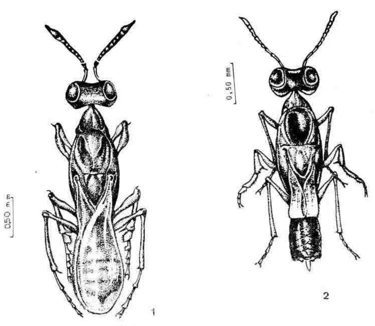Kissing and Assassin Bugs
Brewer M, Gorla D, & Murúa F. 1981
Nuevo aporte al conocimiento de parasitoides oofagos de Triatoma infestans Klug, 1834 (Hemiptera, Reduviidae), en Cruz del Eje, Córdoba, Republica Argentina [Parasitoids of Triatoma infestans eggs (Hemiptera, Reduviidae) in Cruz del Eje, Cordoba, Argentina].
Anais da Sociedade Entomologica do Brasil 10, 175-186.
Preliminary results obtained from sampling egg parasitoids of Triatoma infestans principally, in domestic and peridomestic sites and in wild forest of Cruz del Eje Department, Córdoba, are reported.
No egg of T. infestans in traps placed inside homes and in peridomestic areas was parasitized. A 12 % parasitism was found in peridomestic sites through direct search. Anastatus coreophagus Ashmed, 1904, a new egg parasitoid of T. infestans is recorded. Telenomous fariai Costa Lima, 1927, and Anastatus excavatus De Santis, 1952, are still the most important parasitoids in the forest. A. excavatus has an average development period of 29.32 days in the laboratory. In the adult stage, they can survive up to 10 days, if fed with honey, 3.57 days, if not.
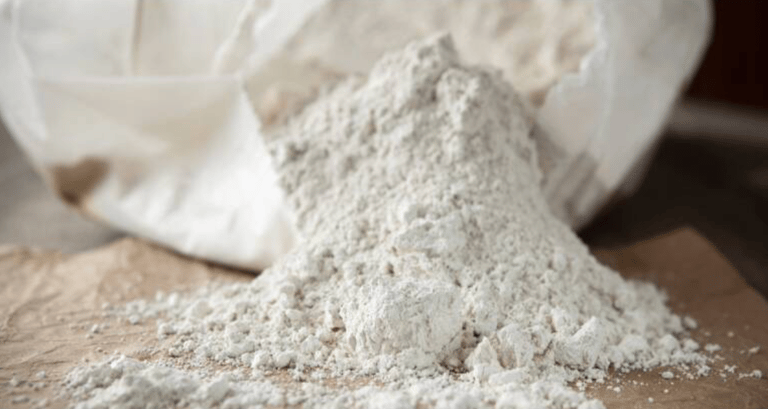

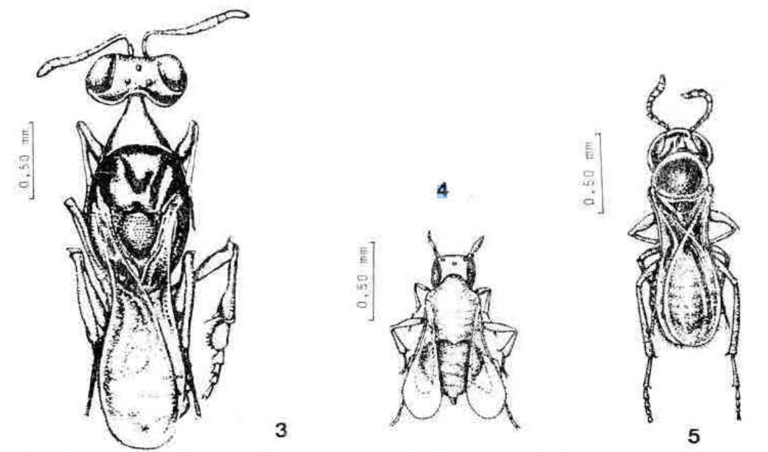

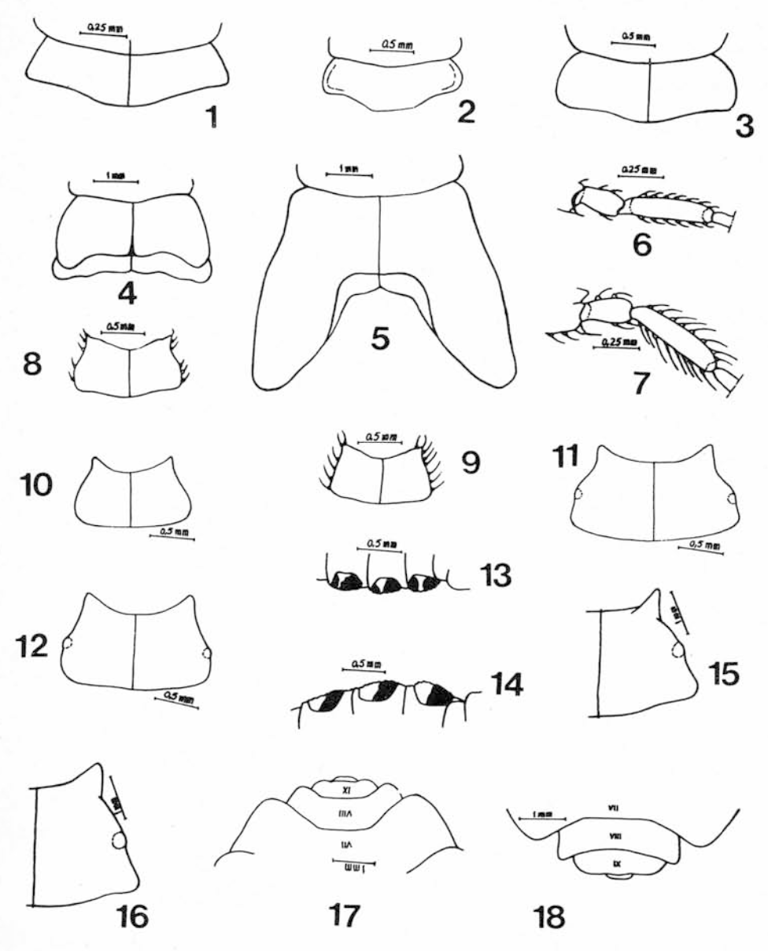

Bilbao M L, Mañá M O, & Murúa F. 2007
Evaluación del efecto insecticida de tierra de diatomeas sobre Triatoma infestans (Hemíptera, Reduviidae) [Evaluation of the insecticidal effect of diatomaceous earth on Triatoma infestans (Hemiptera, Reduviidae)].
Revista Peruana de Medicina Experimental y Salud Publica 24, 179-181.
Triatoma infestans is the main vector of Chagas disease in Argentina. Diatomaceous earth (TD) is a natural product that is currently marketed for insecticidal purposes and causes death by dehydration. The insecticidal efficacy of TD at 60 % purity, from the La Iglesiana mine (San Juan, Argentina) was evaluated on fifth instar nymphs and adults of T. infestans. Two doses were tested: 112.5 g/m2 (T1) and 225 g/m2 (T2), with four replicates per treatment, with five specimens, including the controls (TC) in the laboratory. Live and dead individuals were counted for five days. No differences were found in mortality (ANOVA, p>0.05) in adults (T1: 40 %, T2: 25 % and TC: 30 %) or in fifth instar nymphs (T1: 10%, T2: 15 %). and TC: 10 %). It is concluded that the diatomaceous earth from the La Iglesiana site, under the laboratory conditions evaluated, does not have insecticidal capacity against T. infestans.
Brewer M, Garay M, Gorla D, Murúa F, & Favot R. 1981
Caraterización de los estadios ninfales del genero Triatoma Laporte, 1833. 1. Triatoma infestans Klug, 1834 (Hemiptera, Reduviidae) [Characterization of the nymphal stages of the genus Triatoma Laporte, 1833. 1. Triatoma infestans Klug, 1834 (Hemiptera, Reduviidae)].
Revista de la Sociedad Entomologica Argentina 40, 91-102.
The present study is the first one of a series on Triatominae's nymphs. It deals with Triatoma infestans, the most important species as vector of Chagas' disease in the Argentine Republic. A key for the five nymphal instars and descriptions of each one of these are given.
Brewer M, Garay M, Gorla D, Murúa F, & Favot R. 1983
Caracterización de los estadios ninfales del genero Triatoma Laporte, 1833. II. Triatoma platensis Neiva, 1913, Triatoma delpontei Romana y Abalos, 1947, Triatoma sordida (Stal, 1859) (Hemiptera, Reduviidae) [Characterization of the nymphal stages of the genus Triatoma Laporte 1833. II. Triatoma platensis Neiva, 1913, Triatoma delpontei Romana y Abalos, 1947, Triatoma sordida (Stal, 1859) (Hemiptera, Reduviidae)].
Revista de la Sociedad Entomologica Argentina 42, 219-241.
Characterization of the five nymphal stages of the genus Triatoma Laporte, 1833. 2. Triatoma platensis Neiva, 1913, Triatoma delpontei Romana y Abalos, 1947, Triatoma sordida (Stal, 1859) (Hemiptera, Reduviidae).
This paper is the second contribution of a series about Triatominae's nymphs. It deals with Triatoma platensis Neiva, 1913, Triatoma delpontei Romaña & ALbtios, 1947 and Triatoma sordida (Stal, 1859). They and Triatoma infestans Klug, 1934, were sampled in bird's nests at Córdoba (Argentina). Keys of the five nymphal instars of each species and descriptions of each one of them are published.

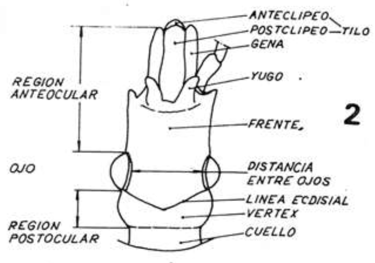
Brewer M, Gorla D, Murúa F, & Favot R. 1984.
Sobre la biologia en laboratório de cuatro especies de parasitoides oofagos de Triatoma infestans Klug, 1834 (Hemiptera, Reduviidae) [On the laboratory biology of four species of oophagous parasitoids of Triatoma infestans (Hemiptera, Reduviidae)].
Anais da Sociedade Entomológica do Brasil 13, 339-355.
Laboratory breeding of four egg parasitoids of Triatoma infestans Klug, 1834 (Hemiptera, Reduviidae).
Preliminary results on the biology in the laboratory of parasitoids obtained from Triatoma infestans’ eggs, exposed inside traps placed in wild forests, are reported.
Anastatus excavatus De Santis, 1952, A. charitios De Santis, 1982, Oolathron mireyae De Santis, 1981, and Ooencyrtus venatorius De Santis et Vidal, 1976, were the parasitoids studied.
Development period, life span, descendants/egg, descendents/female and rate of parasitism were characteristics considered.

